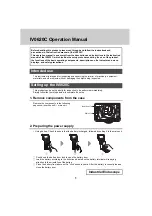
15
16
Non-Contact Voltage (NCV)
1.Hold the “
NCV
” button.
2.Move the tip of the meter toward the object to be tested.
3.If the voltage detected is greater than 90V AC rms, the
NCV indicator will flash and the buzzer will sound.
Note:
•
Even if no indication is given, voltage may still be present.
Do not rely solely on NCV detection to determine the
presence of voltage.
•
When measuring AC/DC voltage, the NCV indicator may
flash due to induced voltage.
•
External power sources/interference may trigger the
NCV indicator.
Temperature (Type-K Thermocouple)
1.nsert the “- COM“ end of the thermocouple into the
“
COM”
jack and “V +” end into the “
INPUT”
jack.
2.Turn the rotary switch to the “
TEMP
” position. The
default mode is °F; press “
FUNC
” to switch to °C if
necessary; press “
FUNC
” to switch back to °F.
3.Touch the tip of the thermocouple to the object to be
tested.
4.Read the measured temperature value on the display.
Specifications
The meter should be calibrated annually between
18
℃
~ 28
℃
and a relative humidity less than 75%.
General Specifications
• Manual and auto range
• Power overload protection
• Maximum voltage between circuit and ground:
1000V AC/DC
• Maximum working height: 2000m
• Display: LCD
• Maximum display value: 5999
• Polarity indication” automatically displays“-”
• Overload indication: “0L” or “-0L”
• Sampling frequency: 3 times/sec
• Units displayed: functions with units.
• Auto power off: 15 mins.
• Power : 1x 9V 6F22 battery
• Low battery indication: display shows“ ”
• Operating temperature: 0
℃
~40
℃
• Storage temperature:-10
℃
~50
℃
• Temperature coefficient: less than 0.1% accuracy/°C
• Size: 201×65×43mm
• Weight: 265g (Including batteries)
Electrical tester
Electrical tester
43
44





































